Japan
Wood Products Prices
Dollar Exchange Rates of 10th
July 2018
Japan Yen 112.50
Reports From Japan
¡¡
Labour
shortages and higher raw material costs
dampen growth
Japan¡¯s economy now appears to be faltering due mainly
to the rising costs of labour, imported raw materials and
oil. But weaker economic indicators did not deter the Bank
of Japan (BoJ) from maintaining its positive assessment of
the economy.
The BoJ Governor went on record saying the 2% inflation
target still stands which analysts have interpreted as
meaning the current monetary policy will be sustained.
The BoJ revised up its assessment for capital expenditure
in three of the nine regions of Japan, attributing this to
company spending on automation as a way to overcome
the acute shortage of workers. On the downside, it said
some companies expressed concern about the risk of an
escalation of the trade dispute between the US and China.

The labour shortage in Japan is becoming a major
concern
in the construction and manufacturing sectors and the
latest population data have done little to raise hopes for a
solution. Japan¡¯s population declined at fastest pace yet to
125.2 million according to the most recent census due
mainly to a record low birth rate. This, combined with the
rapidly aging population has prompted the government to
launch a study to find ways to support families and reverse
the downward trend in the birth rate.
Yen gives up role as safe haven currency
The US dollar is currently at a six-month high against the
Japanese yen. The dollar¡¯s strength relies on the good
performance of the US economy and by US inflation data
which has encouraged capital inflows.
The yen weakness against to dollar at a time when there is
volatility in the global economy suggests traders believe
the dollar is a safer currency than the yen as trade
volatility is likely to worsen.

Thousands of homes lost in floods
As of 14 July the death toll from the devastating floods in
western Japan was above 200. The government¡¯s Chief
Cabinet Secretary has announced that 204 people were
now known to have died with 28 still missing in the worst
storm for 36 years.
Almost 15,000 people are in evacuation centres and many
of these people have no home to return to. At the height
of the storm evacuation orders were issued to around 6
million people.
Authorities are still not clear on the full extent of the
damage. Thousands of homes have been totally or partially
destroyed and infrastructure has been severely damaged. A
government spokesperson has said it will take years for
recovery.
See:
https://www.google.co.jp/search?q=japan+storm+damage&rlz=1
C1GGRV_enJP741JP741&source=lnms&tbm=isch&sa=X&ved
=0ahUKEwipkdiZmKPcAhWKl5QKHSjnDVgQ_AUICigB&bi
w=1366&bih=655
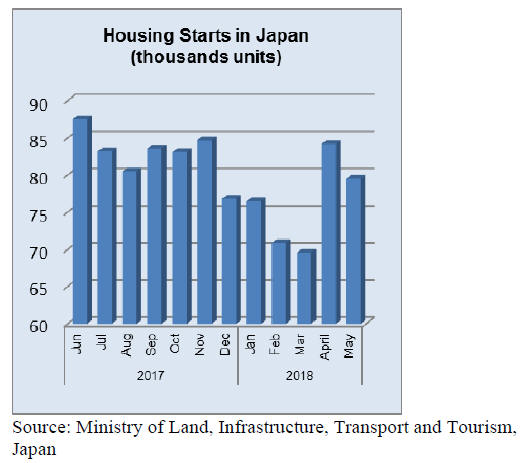
Furniture imports
The total value of Japan¡¯s April 2018 imports of wooden
office, kitchen and bedroom furniture was largely
unchanged from the previous month or from April 2017.
Despite the cyclical trend in wooden bedroom furniture
imports, a category that accounts for a major share of total
wooden furniture imports, year on year there has been
little change in the total value of wooden furniture
imports.
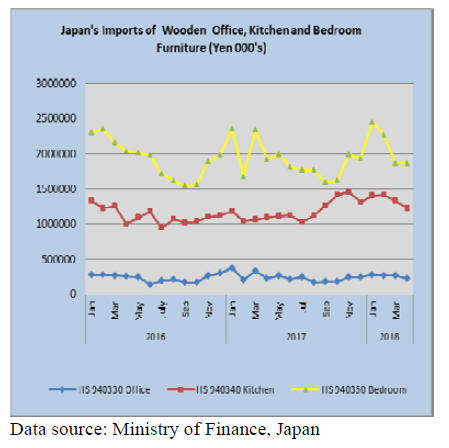
Office furniture imports (HS 940330)
The rising trend in wooden office furniture imports from
the third quarter of 2017 came to an end in April 2018.
The value of April imports were flat year on year and
down 14% compared to the value of March imports. In
April 2018 the big losers were shippers of wooden office
furniture in Portugal, Poland and the US.
Japan¡¯s April imports from China, the number one
supplier, were unchanged from a month earlier and
accounted for 54% of all wooden office furniture imports.
The other main suppliers were Switzerland 9% and the US
8.5%.
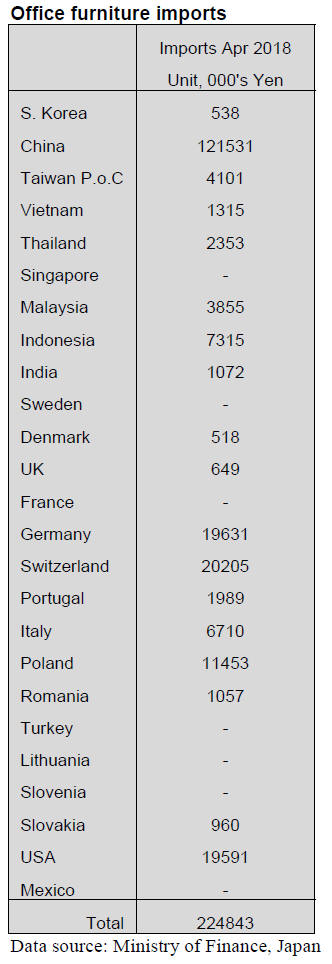
Kitchen furniture imports (HS 940340)
Year on year, the value of Japan¡¯s April 2018 imports of
wooden kitchen furniture were 11.5% higher but
compared to levels in March 2018 they were down 8%.
There has been a steady decline in wooden kitchen
furniture imports since February this year but compared to
the first 4 months of 2017, imports are higher.
Manufacturers in the Philippines have consolidated their
position as the number one supplier of wooden kitchen
furniture to Japan, accounting for 47% of April 2018
import values.
Following closely at a 36% share of April imports by
Japan is Vietnam. Shippers in China added a further 10%
to imports bring the total for the top three shippers to 93%.
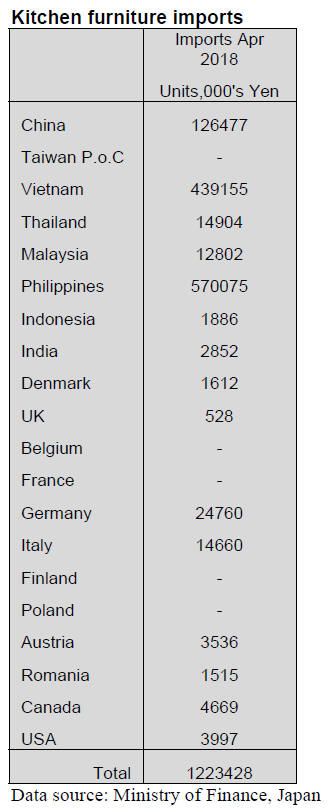
Bedroom furniture imports (HS 940350)
The dramatic slide in imports of wooden bedroom
furniture was arrested in April as the value of imports did
not change compared to levels in March. Year on year and
month on month the value of Japan¡¯s imports of wooden
bedroom furniture remain flat.
Every year wooden bedroom furniture imports peak in the
first half of the year only to drop sharply in the second and
third quarters of the year. On the basis of past trends a
further decline in bedroom furniture imports can be
expected over the next few months.
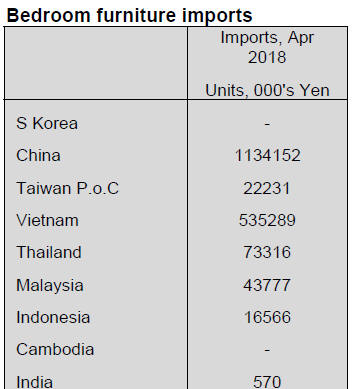 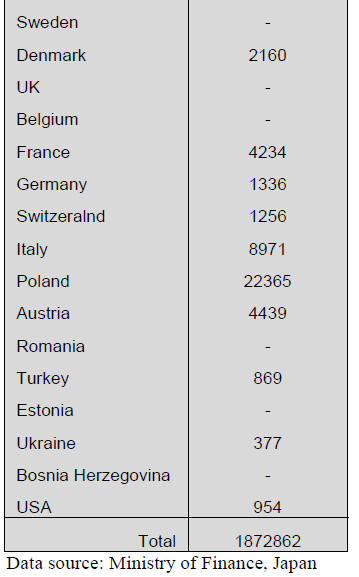
Trade news from the Japan Lumber Reports (JLR)
For the JLR report please see:
http://www.nmokuzai.
com/modules/general/index.php?id=7
Statistics of LVL, CLT and laminated lumber
production
The Ministry of Agriculture, Forestry and Fisheries
publicised wood statistics of 2017 on May 25 and the
Ministry newly added production of LVL, CLT and
laminated lumber for the first time.
In the past such data have been publicized by the
Association of each product but now official government
data become available.
By 2017¡¯s wood statistics, production of LVL is 179,000
cbms, CLT is 14,000 cbms and laminated lumber is
1,971,000 cbms.
In LVL, structural material is 99,000 cbms, 55% in total
then 45% or 80,000 cbms is for interior finishing and other
industrial use. Non-structural LVL is mainly used for
stairs and core of furniture. Industrial use is for crating and
pallet.
In LVL production, 144,000 cbms are made of 100%
domestic wood, which is 80% of total production. 31,000
cbms are made of imported materials only. 4,000 cbms are
made of combination of domestic and imported materials.
Number of LVL manufacturing plant is 13 and total
consumption of veneer to make LVL is 256,000 cbms.
By trade statistics, import of LVL in 2017 was 483,563
cbms, 4% more than 2016. By source, 463,553 cbms or
96% came from China. Supply of LVL by both domestic
and import is about 660 M cbms.
Production of CLT in 2017 was 14,000 cbms. The Japan
CLT Association reported 2016¡¯s production of CLT was
5,000 cbms so the production increased by almost three
time in one year.
JAS for CLT was set in 2013 and the Building Standards
Act authorized use of CLT in 2016 so that CLT
construction became possible by standard structural
calculation. At the same time, CLT is allowed to use
exposed in quasi-fire proof structure.
Presently there are seven JAS certified CLT
manufacturing plants. Cypress Sunadaya is now building
CLT manufacturing plant. With completion of this plant,
total CLT production capacity will largely increase. There
are more than 200 building with CLT so the market of
CLT has been steadily expanding.
The Japan CLT Association figures CLT production this
year would be 30,000 cbms, more than double of last
year¡¯s production.
Production of laminated lumber was 1,971 M cbms by 165
manufacturing plants. In this, structural lumber was
1,858,000 cbms, 94.3% of total production. By size, large
was 55,000 cbms, medium was 855,000 cbms and small
was 938,000 cbms.. Consumption of lamina was
2,755,000 cbms, in which domestic lamina was 908,000
cbms and imported lamina was 1,847,000 cbms. Share of
domestic lamina was 33.0%. The market continues
stagnating.
Legality proven imported wood
The Japan Lumber Importers Association held the general
meeting on June 8 and collected information from
members regarding legality proven wood in imported
wood products.
In total imported wood products of logs, lumber,
plywood, veneer, laminated lumber, fiber board, particle
board and OSB, 5,953,000 cbms were legally proven,
which take 74.9% of total imported products. This is 3
points up from 2016. However, the volume sold with the
certificate in the market was only 38.9%, 2.3 points less
than 2016.
The reason is that materials with certificate and without
certificate are mixed since separation is complicated and
too much trouble. Unless buyers demand certified wood
separate from non-certified products, there is limit of
distribution volume.
South Sea (tropical) logs and lumber
After Sabah announced temporary ban of log export,
Japanese importers are busy looking for substitution
sources since Sabah logs were about an half of total log
import of 140,000 cbms last year. Logs from PNG and
Africa, veneer and flitch from Russia and South East Asia
are candidates.
So far, log export prices in South East Asia remain
unchanged. Percentage of Sabah logs for India and China
is not so much but if they rush to PNG, log prices would
escalate again.
Supply decline of solid wood lumber of tropical
hardwood domestic mills make is feared since material
logs are sorted out of plywood logs so once total log
supply declines, such selection becomes difficult.
South Sea (tropical) hardwood plywood
Log supply continues tight in Sarawak even after dry
season arrived. According to Sarawak Timber Association,
total log production in 2017 was 5,490,000 cbms, 26% or
1,923,400 cbms less than 2016. Log production in the first
quarter of 2018 is 1,026,000 cbms, 29.4% less than the
same quarter last year. One of the reasons is foul weather.
Even after rainy season was over last year, sporadic heavy
rain hit many areasin Sarawak.
By log supply shortage, plywood production dropped by
half in June 2017 and log inventories of many
plywood mills dropped down to ten days or two weeks
through 2017. Log inventory differs by plywood mills by
political reasons or by source of timber, fee or purchase
logs.
Ta Ann uses more plantation wood like eucalyptus for
coated concrete forming panel. In May, it proposed $680
per cbm C&F for JAS 3x6 concrete forming plywood,
record high price in Sarawak. Shin Yang¡¯s prices are about
$650. Not only weather but other factors like many local
holidays reduce log supply through July.
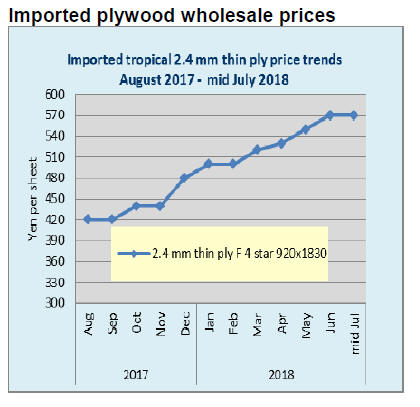 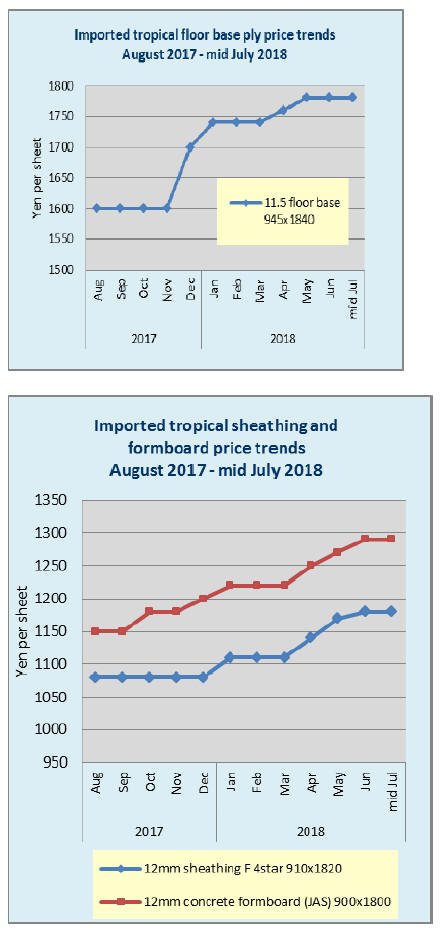
Tight supply of particleboard for flooring
Demand for 2x6 particleboard for flooring was busy last
year then it simmered down in early this year. The demand
is rising again now with increasing starts of high rise
condominiums and Olympic related constructions.
The manufacturers have orders for other items for building
materials so they have no time to build up inventory of
2x6 sheet. Actually the inventory now is much lower than
this time of last year.
There are many plans of large condominiums then
construction of many facilities for the 2020¡¯s Olympic
Games will start in summer.
Market prices of 2x6 PB are 850 yen per sheet delivered
wholesaler but in demand busy Kyushu market, the prices
are getting close to 900 yen. With the supply getting tight,
the prices continue firming everywhere.
Stabilising supply of Vietnamese plywood
Tight supply of eucalyptus plywood from Vietnam is now
easing after purchase by China and Korea slows down.
Operation of producing plants is not uniform in securing
raw materials and financial stability so the future supply
situation is not optimistic.
Veneer supply in Vietnam is stabilising so the volume for
Japan is sufficiently secured. Export prices stay up high
but at the same time, any sharp increase is unlikely. The
importers and wholesalers give priority to secure enough
volume rather than the prices for coming fall demand
increase.
|